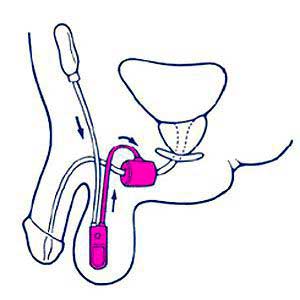Artificial Urinary sphincter for male urinary incontinencea
Urinary incontinence refers to the involuntary loss of urine at inappropriate times or places such that it causes hygiene or social problems.
In males, this kind of incontinence is rare and generally due to trauma and/or surgical interventions to the urinary sphincter, or to neurological diseases compromising the innervation of the bladder and urethra. In other cases, the person experiences a sudden strong desire to urinate and has to hurry to the toilet, but may “wet himself” before he gets there. The urinary flow ranges from a few drops to full micturition and are both frequent and unpredictable. In this case, we refer to urgency urinary incontinence.
In most cases, the disorder is associated with frequent, involuntary and unstoppable contractions of the bladder muscle. Its causes included neurological disease, urinary tract infections, calculi and bladder tumors. This type of incontinence is frequently seen in the elderly, particularly in those with cerebral disease (arteriosclerosis, Parkinson’s disease, etc.) and is aggravated by gait and balance disorders, as well as mental confusion. The AMS 800 device is used to treat urinary incontinence due to resistance to urinary flow in the urethra/bladder (intrinsic sphincteric deficiency) in male, female and pediatric patients.
The AMS 800 sphincter is a reliable device for the treatment of incontinence in appropriately selected patients. The artificial sphincter is currently the best treatment for incontinence due to a sphincteric deficiency subsequent to radical prostatectomy. The positioning of an artificial sphincter for sphincteric insufficiency produces satisfactory continence in 80-90% of cases. It simulates a healthy sphincter insofar as it maintains the urethra closed until urination is desired. The artificial urinary sphincter is a small, surgically implanted device which aims to restore the natural micturition control process.
When the natural sphincter, that is, the muscle responsible for the control of micturition, does not function correctly, as may occur following a prostatectomy, uncontrollable urine loss is observed. In cases of severe incontinence, where rehabilitation techniques and pelvic floor physiotherapy are insufficient to restore continence mechanisms, the use of an artificial sphincter may represent a solution to the problem. It is made up of three components: a cuff, which surrounds and closes the urethra, a pump located in the scrotum to deflate the cuff and a reservoir balloon. These components are connected together with flexible tubes.
Where is the device implanted?
Balloon (reservoir): positioned close to the bladder. Tubes: connect the different parts of the device, allowing for the movement of liquid within. Cuff: positioned around the urethra. De-activation valve: a small button on the stiff part of the pump. Pump: positioned within the scrotum such that it can be felt through the skin. The lower part is soft and distensible. The liquid-filled cuff applies gentle pressure to keep the urethra closed and thus hold the urine in the bladder.
In order to urinate, the patient presses the pump several times. The liquid is thus transferred into the reservoir and the cuff remains open. Once emptied, the cuff no longer exerts pressure on the urethra and urine is able to flow out of the bladder. A few minutes after micturition, the liquid automatically returns to the cuff’s balloon, which fills up to close the urethra, once again restoring continence.
The surgical procedure for the implantation of the artificial urinary sphincter can be carried out as a Day Surgery, involving a single 3cm incision below the scrotum. It is necessary to wait 30 days after the procedure before starting to use the device.

